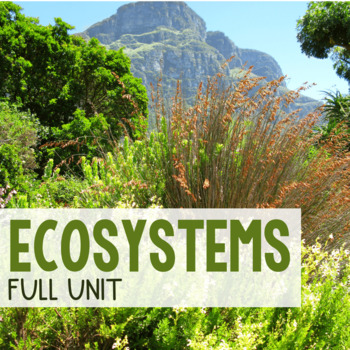Ecosystems - FULL UNIT
- Zip
- Easel Activity
- Easel Assessment
Products in this Bundle (32)
showing 1-5 of 32 products
Also included in
- Is lesson planning just too much on top of teaching on top of grading on top of classroom management on top of *ahem* living your life? Get all the guidance you need to teach a full-year science course in person, hybrid, or virtual with my all-inclusive curriculum bundle! This curriculum will savePrice $410.00Original Price $583.99Save $173.99
Description
Is lesson planning just too much on top of teaching on top of grading on top of classroom management on top of *ahem* living your life? Get all the guidance you need to teach a comprehensive, no-prep ecology unit either in person, hybrid, or virtual with my all inclusive unit bundle!
This unit will save you time, engage your students, and wow your administrators!
Included Materials:
Presentations
- Ecosystems
- Populations
- Food Webs & Energy Pyramids
- Interactions of Living Things
- Carbon Cycle
- Nitrogen Cycle
- Biodiversity
Student Practice and Activities:
- Biomes Webquest
- Biome Guided Practice
- Biotic & Abiotic Factors
- Biodiversity Guided Practice
- Water Cycle Guided Practice
- Carbon Cycle Guided Practice
- Nitrogen Cycle Guided Reading
- Symbiosis Guided Reading
- Symbiosis Color by Number
- Ecological Succession Guided Reading
- Food Webs & Energy Pyramids Guided Practice
- Food Web Practice
- Invasive Species Guided Practice
- Carrying Capacity & Limiting Factors Guided Practice
- Population Density, Random Sampling, Mark & Recapture Worksheets
- Ecosystem Guided Practice
- Endangered and Extinct Species Research Assignment
- Create a Food Web
- Biosphere Reading Assignment
Assessments
Projects:
Topics covered in this unit include:
- What is an ecosystem?
- Energy Transfer (food webs, energy pyramids)
- Interactions (symbiosis, invasive species)
- Populations
- Abiotic Cycles (Carbon, Nitrogen, Water)
- Maintaining Biodiversity
Key Features of this Unit:
- Can be implemented in person, hybrid, or virtual
- Several engaging Google Slides lessons
- Several guided reading resources for homework or class practice
- Project based learning
- Formative and summative assessment
Who is this resource for?
This resource can be used by classroom teachers, tutors, and parents of students in grades 6-9. It comprehensively covers the topics mentioned, and provides a variety of practice opportunities to suit learners of all different levels and learning styles.
This resource is ideal for teachers who teach in person, online, or hybrid. Digital versions are included with all resources to make lesson planning a breeze!
What's Included?
Most of the resources in this bundle will be downloaded as a PDF file in color. If a digital file is connected to that resource, as it is in most cases, you will find the link in a large font on page 2 of the PDF. For resources that are printer friendly, the remaining pages of the PDF can be printed and copied. All relevant resources include an answer key at the end of the file.
I do not use zip files, instead I package my resources in PDFs as a single document from start to finish. Make sure to scroll through the entire resource if you’re looking for an answer key or alternate version!
Please take a look at the individual product preview files to see more of the resources included in this bundle.
How do I teach this unit?
Grab the free unit guide that corresponds to this unit by downloading it here in PDF format.
For questions and support:
Email me at laneyleeteaches@gmail.com
---------------------------------------------------------------------------------------------------------------
To stay updated on sales and new products, please follow my store:
Connect and chat with me!




